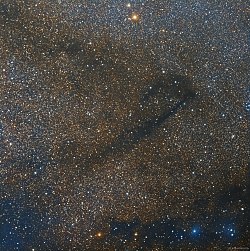 α and 8 Vulpeculae form a pair at top center | |
| Observation data Epoch J2000.0 Equinox J2000.0 | |
|---|---|
| Constellation | Vulpecula |
| Right ascension | 19 28 57.08327 |
| Declination | 24° 46′ 07.2656″ |
| Apparent magnitude (V) | 5.82 |
| Characteristics | |
| Spectral type | K0 III |
| B−V color index | 1.023±0.005 |
| Astrometry | |
| Radial velocity (Rv) | −28.58±0.20 km/s |
| Proper motion (μ) | RA: 8.750 mas/yr Dec.: 16.334 mas/yr |
| Parallax (π) | 7.1397 ± 0.0739 mas |
| Distance | 457 ± 5 ly (140 ± 1 pc) |
| Absolute magnitude (MV) | −0.16 |
| Details | |
| Mass | 3.07 M☉ |
| Radius | 13.8+0.2 −0.4 R☉ |
| Luminosity | 100.5±1.3 L☉ |
| Surface gravity (log g) | 2.63 cgs |
| Temperature | 4,915+71 −30 K |
| Metallicity | +0.11 dex |
| Age | 324 Myr |
| Other designations | |
| 8 Vul, BD+24 3761, HD 183491, HIP 95785, HR 7406, SAO 87267 | |
| Database references | |
| SIMBAD | data |
8 Vulpeculae is star located about 457 light years away in the northern constellation of Vulpecula. It lies just 7′ from Alpha Vulpeculae and the two form an optical double. 8 Vulpeculae is visible to the naked eye as a faint, yellow-orange hued star with an apparent visual magnitude of 5.82. It is moving closer to the Earth with a heliocentric radial velocity of −29 km/s.
This is an aging giant star with a stellar classification of K0 III, which indicates it has exhausted the hydrogen supply at its core and evolved away from the main sequence. It is 324 million years old with three times the mass of the Sun and has expanded to 14 times the Sun's radius. The star is radiating 100 times the Sun's luminosity from its enlarged photosphere at an effective temperature of 4,915 K.
References
- ^ Brown, A. G. A.; et al. (Gaia collaboration) (August 2018). "Gaia Data Release 2: Summary of the contents and survey properties". Astronomy & Astrophysics. 616. A1. arXiv:1804.09365. Bibcode:2018A&A...616A...1G. doi:10.1051/0004-6361/201833051. Gaia DR2 record for this source at VizieR.
- ^ Anderson, E.; Francis, Ch. (2012). "XHIP: An extended hipparcos compilation". Astronomy Letters. 38 (5): 331. arXiv:1108.4971. Bibcode:2012AstL...38..331A. doi:10.1134/S1063773712050015. S2CID 119257644.
- ^ Yoss, Kenneth M. (November 1961), "Spectral and Luminosity Classifications and Measurements of the Strength of Cyanogen Absorption for Late-Type Stars from Objective-Prism Spectra.", Astrophysical Journal, 134: 809, Bibcode:1961ApJ...134..809Y, doi:10.1086/147209
- ^ Liu, Y. J.; et al. (April 2014), "The Lithium Abundances of a Large Sample of Red Giants", The Astrophysical Journal, 785 (2): 12, arXiv:1404.1687, Bibcode:2014ApJ...785...94L, doi:10.1088/0004-637X/785/2/94, S2CID 119226316, 94.
- ^ Takeda, Yoichi; et al. (August 2008), "Stellar parameters and elemental abundances of late-G giants", Publications of the Astronomical Society of Japan, 60 (4): 781–802, arXiv:0805.2434, Bibcode:2008PASJ...60..781T, doi:10.1093/pasj/60.4.781
- ^ "8 Vul". SIMBAD. Centre de données astronomiques de Strasbourg. Retrieved 2018-11-19.
- Mason, Brian D.; et al. (2001). "The 2001 US Naval Observatory Double Star CD-ROM. I. The Washington Double Star Catalog". The Astronomical Journal. 122 (6): 3466–3471. Bibcode:2001AJ....122.3466M. doi:10.1086/323920. ISSN 0004-6256.
External links
- 8 Vulpeculae on WikiSky: DSS2, SDSS, GALEX, IRAS, Hydrogen α, X-Ray, Astrophoto, Sky Map, Articles and images
| Constellation of Vulpecula | |||||||||||||
|---|---|---|---|---|---|---|---|---|---|---|---|---|---|
| Stars |
| ||||||||||||
| |||||||||||||
| |||||||||||||
| |||||||||||||
| Galaxies |
| ||||||||||||
| |||||||||||||